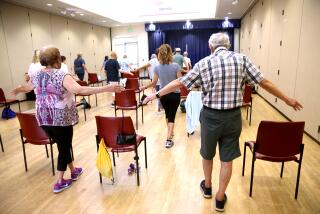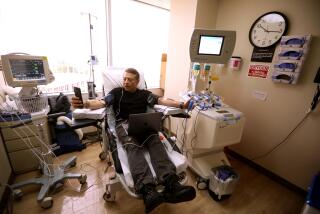‘Fountain of Youth’ Eludes Experts on Age
- Share via
WASHINGTON — Dr. Roy Walford, thin and fit, fasts two days a week and otherwise follows a strict diet that averages just 1,500 calories a day. Inspired by lean laboratory rats who have lived extraordinarily long and healthful lives on short rations, the UCLA medical doctor and research scientist is firmly convinced that his regimen could help a person live to be 120.
Will the Walford diet really increase longevity? “Only if you’re a rat or a mouse,” says Dr. Edward Schneider, deputy director of the National Institute of Aging. He insists that nothing can extend the human life span--not diet, not exercise, not vitamins.
Perpetual Fascination
Walford and Schneider represent opposite viewpoints of science’s perpetual fascination with the idea of prolonging life. It is a preoccupation that dates back at least 450 years, to Ponce de Leon’s futile search for the “fountain of youth.”
Today’s explorers for longevity, instead of combing the wilds of southern Florida, are peering into microscopes, rearranging genes and running tests on healthy people in their 80s and 90s.
For all the research, however, science and medicine have uncovered little about the vital subject of aging--what it is, why it happens and whether it can be retarded.
“We all see people who we were in school with 20 years ago,” said Dr. John Rowe, director of the Harvard Medical School’s division on aging. “Some of them look like they haven’t aged at all, and others look like it’s been a very tough 20 years. There must be something we can measure to show why a person is aging faster or slower, but to date, we have not been able to develop that marker of aging.”
Nor do scientists know exactly why people wear out and die, although they believe that an intriguing mixture of hereditary and environmental factors seems to determine how long an individual lives.
“Probably half of what happens to us is genetic and the other half is in our own hands, including our life style,” said Dr. Robert Butler, chairman of the geriatrics department at Mount Sinai Medical Center in New York.
Each species seems to have its own life span: one month for a fruit fly, three years for a mouse, 150 years for a giant tortoise.
Life as ‘Terminal Disease’
“Life itself may be considered a terminal disease to which we are all committed long before birth,” said Philip Hanawalt, chairman of the Stanford University biology department. “The clock is probably set as soon as the fertilized egg begins to grow.”
It is a clock that man has always dreamed of cheating. “I think we would all like to believe there’s someplace in the world where the hand of time rests a little less heavily on the human brow,” said Dr. J. Edwin Seegmiller of the Institute for Research on Aging at UC San Diego.
For the human species, however, the clock apparently is set for a maximum of 115 years. Methuselah notwithstanding, there is no well-documented case of a human being having lived longer.
Hardy Soviet Peasants
The hardy peasants of the Caucasus Mountains in the Soviet Union were once said to live 140 years and longer on their diet of yogurt. The reality proved less spectacular than the lore, however: Czarist Russia drafted men between the ages of 18 and 55 during World War I, and so, Seegmiller said, “there was a considerable incentive for persons to adopt the birth dates of their fathers.”
Villacabamba, a village in Ecuador, also enjoyed a vogue as a land of the long-lived--until it was discovered that people there were celebrating three or four birthdays each year. “One old gentleman claimed to be 132, but three years before, he had reported his age as just 121,” said Seegmiller, who accompanied an expedition there.
Until very recently, living to a very old age was a phenomenon.
“This is the first century of old age, the first century in which old people are mass produced,” said Butler, who recently summoned experts to Mount Sinai Medical Center for a seminar on biological theories of aging. A girl born in the United States today can expect to live 78.3 years; a boy 71.1 years.
Survival of Human Race
For the human race merely to survive, individuals need not live much beyond the age of 30, said Leonard Hayflick, director of the University of Florida’s Institute on Aging. They must live to the age of sexual maturity, reproduce and then rear the young until they, in turn, are ready to mate.
“Why do we age, therefore, may be the wrong question,” Hayflick said. “The right question may be, ‘Why do we live as long as we do?’ ”
The answer seems to be related to the body’s tremendous reserve capacity, its ability to flourish with just one lung or one kidney, to fight off infection and repair damage from accidents.
Time drains this reservoir of strength. Pneumonia, which may send a 30-year-old to bed for three days, has a 30% chance of killing an 85-year-old. “The older you are,” Walford said, “the less it takes to finish you off.”
To state that this is so, however, is not to say why. Theories focus on the ability of parts of the body--perhaps individual cells, perhaps entire organs--to repair the damage they sustain in the ordinary course of living. Each cell routinely suffers 4,000 lesions every hour, according to research done by Raymond Tice of the Brookhaven National Laboratory in New York.
Harmful Chemicals
Normal breathing and digestion generate chemicals that are harmful to the basic substance of heredity--known as DNA--that tells the body’s cells how to do their work. The accumulated damage to the DNA (deoxyribonucleic acid) makes the body age, according to this theory, because of interruptions in the smooth transfer of orders from the DNA to keep the cells working correctly.
Each organ system has repair enzymes that patrol like soldiers, fixing breaks in the DNA. This ability to make repairs, which is at its peak in the human embryo while the specialized body parts are forming, declines after birth like a light operated by a dimmer switch, says Joan Smith-Sonneborn, professor of zoology and physiology at the University of Wyoming.
“We might discover a way to restore the potential for maximum repair,” she said. “It might be possible to turn up the switch.”
Wandering Destroyers
Another damage theory of aging focuses on wandering destroyers, known as “free radicals,” chemically reactive molecules that can tear cell membranes. Free radicals come from the cells’ negative reaction to radiation, to air pollution and even to some of the oxygen we breathe. Instead of being used to produce energy, this oxygen becomes a troublemaker, ripping cells or attacking their DNA.
The body has scavenger compounds that fight the free radicals, but this continuous battle leaves permanent, low-level damage. If aging is the accumulation of cell damage, perhaps it could be retarded if the body could produce more of the compounds, known as antioxidants, that fight free radicals.
Whatever the causes of aging, the 62-year-old Walford thinks he can delay the onset of deterioration through vigorous exercise and a diet that leans heavily to salads, fruit and fish, with some vitamin supplements. At 5 feet, 8 inches, he has weighed 155 pounds for most of his adult life, but has cut his weight to 140 over the last five years.
‘It’s Good to Be Skinny’
Walford, though well respected among his scientific peers, has not converted any of them to his personal regimen. When the members of a panel of eight doctors and scientists at the Mount Sinai aging conference were asked if they would follow the Walford diet, there was a pause of at least 30 seconds. Finally, one man said: “It works for mice and rats.” Another said: “It’s good to be skinny.”
Not everyone is even convinced of that. Dr. Reubin Andres, clinical director of the National Institute of Aging’s Gerontology Research Center in Baltimore, found, in a long-term study of aging in a group of 1,000 people, that it is healthful to put on a few pounds with age--that those most likely to die young are the thinnest and the fattest.
When the two scientists offered their conflicting theories to a meeting of gerontologists last year, Walford asked for a show of hands to indicate who had won the debate. “It was about 50-50,” he said. “Everyone who was overweight thought I was wrong, and all the others thought I was right.”
The argument will probably outlive all the scientists on both sides.
“I can only give you the recommended dietary allowances, with any confidence, for calcium and Vitamin D for older individuals,” said Schneider of the National Institute on Aging. “And, as far as exercise is concerned, I can only vaguely tell you that walking at a good, brisk pace will be good for you.
“I don’t have any magic diets, and I don’t have any magic pills for you,” said the 46-year-old physician, whose personal recipe for longevity includes wearing a seat belt when in a car, eating in good restaurants and enjoying stress-reducing vacations.






